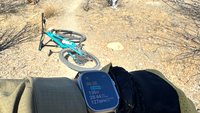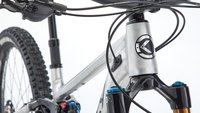
Review: Marzocchi 44 Micro Switch TA
With the big names finally pumping out proper all-mountain 29er forks, you’d be forgiven for forgetting that back in 2009, Marzocchi was the first mainstream manufacturer to offer a 140mm suspension fork for 29” wheels. While the 44 Micro may no longer sit atop the wagon wheel food chain, we were keen to see what kind of terrain the OG of long travel 29er forks could handle 3 years after its debut.

In the interest of a thorough review, the fork spent time on both a hardtail (Transition TransAm 29 v1) and full suspension (Banshee Prime v1) 29er, and as much time as possible in the woods.
At first glance, the 44 Micro ticks all of the boxes for a modern trail fork: 32mm nickel plated stanchions, Marzcocchi’s own QR 15mm axle, burly forged crown and lowers, and a tapered alloy steerer tube. The adjustment knobs are machined aluminum with a low-key anodizing colour treatment – classy.
The 44 uses an air main/positive spring and a coil negative spring. Rebound is externally adjustable via a knob on the bottom of right fork leg. Compression is adjustable via the TST Micro knobs on top of the left fork leg: the outer dial engages the compression damper; while the inner, golden knob (micro) adjusts the level of dampening it provides.

The TST Micro: Marzocchi’s closed cartridge hydraulic compression damping system. The golden micro adjustment knob sets the level of damping, from “just-a-bit-stiffer-there” to “full-on lockout,” the black knob engages the damper.
Atop the 44 Micro’s right fork leg is a new feature for 2013. Gone is the air-spring volume adjust knob of yore; in its place is a simple dial with two settings: Climb and DH. This is the Switch TA, which adjusts the fork’s travel: in Climb mode, the slightest weight over the fork with drop the travel down to 110mm to assist with ascents; in DH mode, the fork pops back up to 140mm of travel. The “switch” is all but instantaneous, achieved with a flick of a dial and even the slightest shift in the rider’s weight: a modern, if less extreme, analogue of Marzocchi’s venerable ETA travel adjust system.

Marzocchi’s Switch TA hydraulic travel adjust system drops the fork 30mm in uphill mode, and brings it back to full travel to shred the DH, all with the flick of a switch.
After quickly walking me through of the fork’s main features and adjustments, Alex from Marzocchi Canada chopped the steerer tube down, recommended a baseline spring-rate and handed over the fork. It was bolted to a new hardtail build and unleashed on the Shore in short order.

Even though it boasts 5.5″ of travel, Marzocchi bills the 44 as a Trail fork. Which explains the presence of the water bottle.
Set up was dead easy: add air until desired sag was reached (ah, the simplicity of a single air spring), dial in the rebound, tighten the qr and off we go. First impressions of the air spring were positive: it was plush and linear, without a noticeable break-in period or much initial stiction. The travel adjust worked as advertized, the knob easy to activate on the fly with gloved hands, and was appreciated on the hardtail. Engaging the Switch TA also seemed to adjust the fork’s spring rate accordingly, so both travel settings were useful for trail riding.

Marzocchi may not currently be a threat to the big suspension dogs of the bike industry. But like they say: it’s not the size of the dog in the fight…
Structurally the fork seemed solid considering its long-legs and sub 5-pound weight. Torsional rigidity matched the rest of the bikes – the fork spent the second half of the test on a Banshee Prime – and hard braking and steep trails produced little noticeable fore-aft flexing.
Once the Shore’s higher altitudes and other trail systems opened up, however, fork’s limitations started to show. In faster, gnarlier terrain, the plush feel that I’d appreciated on mellower trails disappeared: the fork packed up quickly, especially during braking, in the face of steep terrain or successive impacts. Adding more air or engaging the TST and ramping up the micro helped the fork ride higher in its travel and retain its composure on bigger hits and drops, but at the noticeable expense of small bump compliance. I would find myself wanting to twist the TST knob a dozen times over the course of a ride, but usually just ended up sticking to a setting and gritting my teeth during those portions of trail that it didn’t suit.

Whenever we’re out shooting pictures for a review, Morgan always complains that they come out too brown.
A quick chat with the guys at Marzocchi Canada with some initial feedback and the fork was back in their hands for some TLC and tuning. Nothing fancy – they removed the foam rings, lubed the seals with MolyKote and replaced the factory lubricating oil with Golden Spectro – but the result was noticeable: smoother action off the top allowed me to add more air to the spring, which helped the fork to ride firmer and higher in its travel, without sacrificing sensitivity. During the first part of this review I found myself constantly tweaking and changing my settings on the fork, trying to get it dialled in just right. Once I became familiar with the adjustments and found a few key settings I could get the fork to work in just about any trail condition, but the range of utility for a given setting was quite narrow, and the constant tweaking was distracting. In the dozen rides I’ve had since I got it back, the fork works just fine in full open in all but the most brutal terrain, in which engaging the TST with the micro set at minimum seems to add just enough damping to ensure the fork remains composed through chunder and harsh compressions.
I’ve thoroughly enjoyed the second half of my time aboard the Marzocchi 44 Micro Switch TA. There are cheaper or lighter options on the market, but its solid chassis and performance, build quality and relative uncommonness help this fork stand out. And over the medium-term, durability of both the internals and the chassis have been a non-issue. Its a shame that the fork needs to be cracked open and tuned before it can live up to its potential, but hardly an uncommon one these days.
It’s nice to see that Marzocchi is back on track after some time in the wilderness. Anyone else interested to see what’s next for the big red M?









Comments
james
10 years, 7 months ago
how did the fork do on the Prime? given it's extremely slack geo and capability, i would think it might be undergunned. how did it compare to the fork that is normally on the Prime? that would be more illuminating. did the owner of the Prime prefer the Marz to his current fork?
Reply
boomforeal
10 years, 7 months ago
keep in mind i'm a lightweight rider, and my prime has a qr rear end, but i found the 44 a good match - both in terms of stiffness and travel - to the rear end of the prime. i usually run a 140mm revelation rlt ti up front, and the 44 felt a bit more plush and solid than the rev, though not quite as composed at speed
Reply
Andrew Major
10 years, 7 months ago
I think the important moral of this story (and almost every fork review I read) is that, no matter what fork your purchase, it is a good idea to drop the lowers and do a basic service (lubricate foam rings and bushings).
.
The opportunity that Marzocchi is missing, by chasing RockShox/Fox down the road of more features and lighter weights (air springs), is to fill the same niche for 29'ers that they fill for 26'ers - namely ultra reliable, extremely smooth, super easy to service, coil sprung forks.
There is a market for a coil sprung 44 RC3 - no one covers the, admittedly niche, demand for such a product in the 29'er world.
None of the 44 Air Forks I have tried can compare to what RockShox / Fox are offering at the high end of the market (weight / performance) or the value that X-Fusion (performance per $) is offering at the lower end of the market.
-D
Reply
boomforeal
10 years, 7 months ago
agree that marzocchi is missing an opportunity to play to their strengths and build a niche here. but they seem keen to engage fox and rs on the big playing field - maybe they're not content with being a niche player? it will be interesting to see whether their future offerings match their aspirations
Reply
Please log in to leave a comment.